#Our justice system is not a tool of justice; our justice system is a tool of status and power goes to whomever can afford it.
Text
-
#Actually#One thing I will say about this trial and then be done with it is that people should be careful not to catastrophize because of the#verdict. 'Oh so women can't do [x] without [y] now'#Incorrect lol. There is no 'now' because women have always been victims of an unjust system. Absolutely nothing has changed and#nothing was going to change because our system is structured so that victims period (regardless of gender) always come out on the bottom#Our justice system is not a tool of justice; our justice system is a tool of status and power goes to whomever can afford it.#Sorry I don't know who thought this was ever going to be fair but it wasn't#A high-profile case with two high-profile clients seeking equally high-profile goals from this verdict and you guys thought this was#gonna be a nice fair little playdate?#Couldn't be me#Hollywood and politics do not mesh well; the rich pay for the outcomes they want and if you didn't get the outcome you#wanted I guess that means you didn't pay enough.#But this whole idea that Amber's loss is a loss for the people is sooo... lol. like when were victims ever in a position to win within a#system that protects abusers?#You can't say 364 days a year that rich people experience the world differently than ordinary people do#and then claim that Amber's loss has some bearing on Normal People#It does not <3#Amber was in a far better position to win than you or I or Sally from down the street and she still didn't and if you think that's just#because she's a Woman I encourage you to develop some perspective that's not so narrowly focused. There's a bigger picture here than#women good men bad but the way you guys reduce major historical or social events to these segmented points instead of observing them#as part of a whole is so frustrating.#Misogyny is a fraction of a bigger problem here. If you're going to be mad about something be mad about all facets of the social structure#rather than just highlighting one and creating an entire false narrative around it.
8 notes
·
View notes
Text
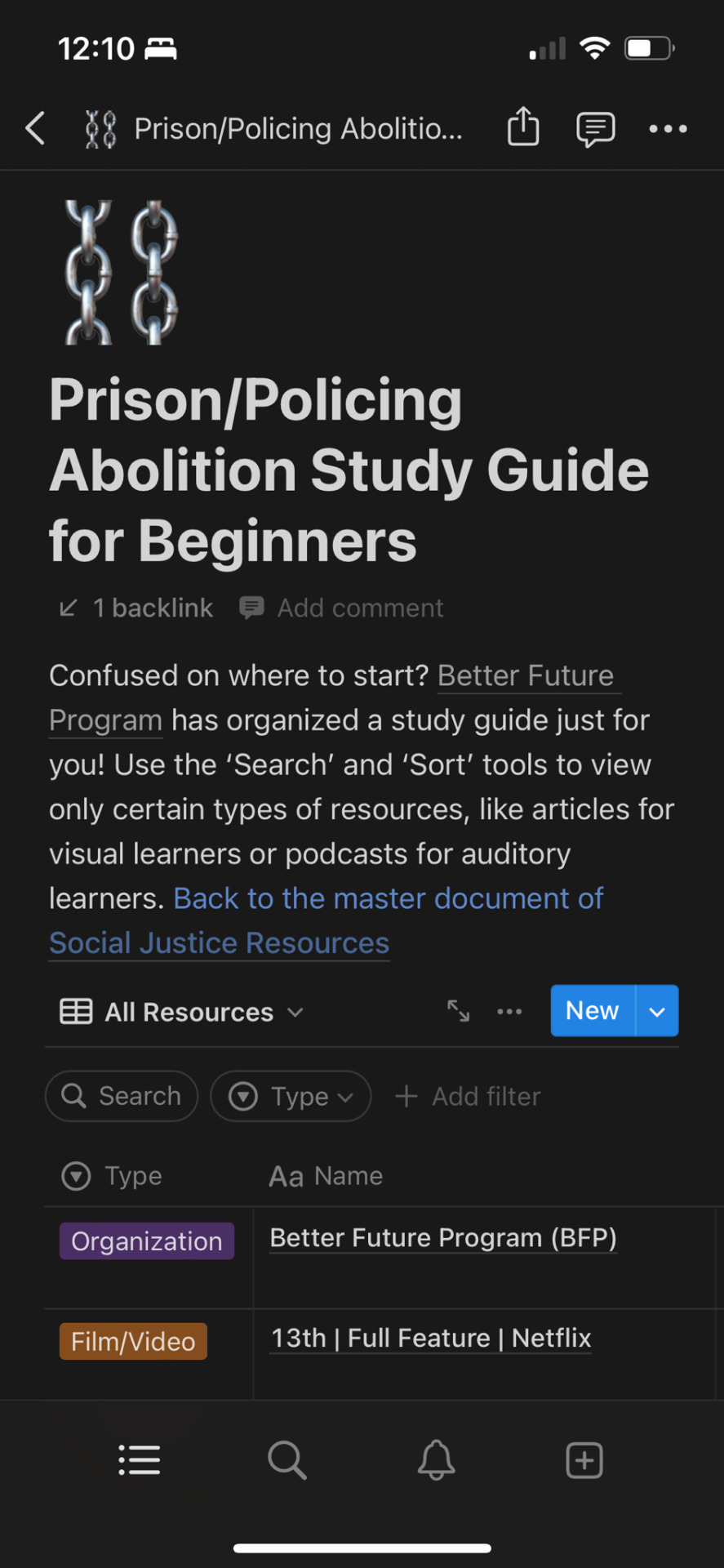
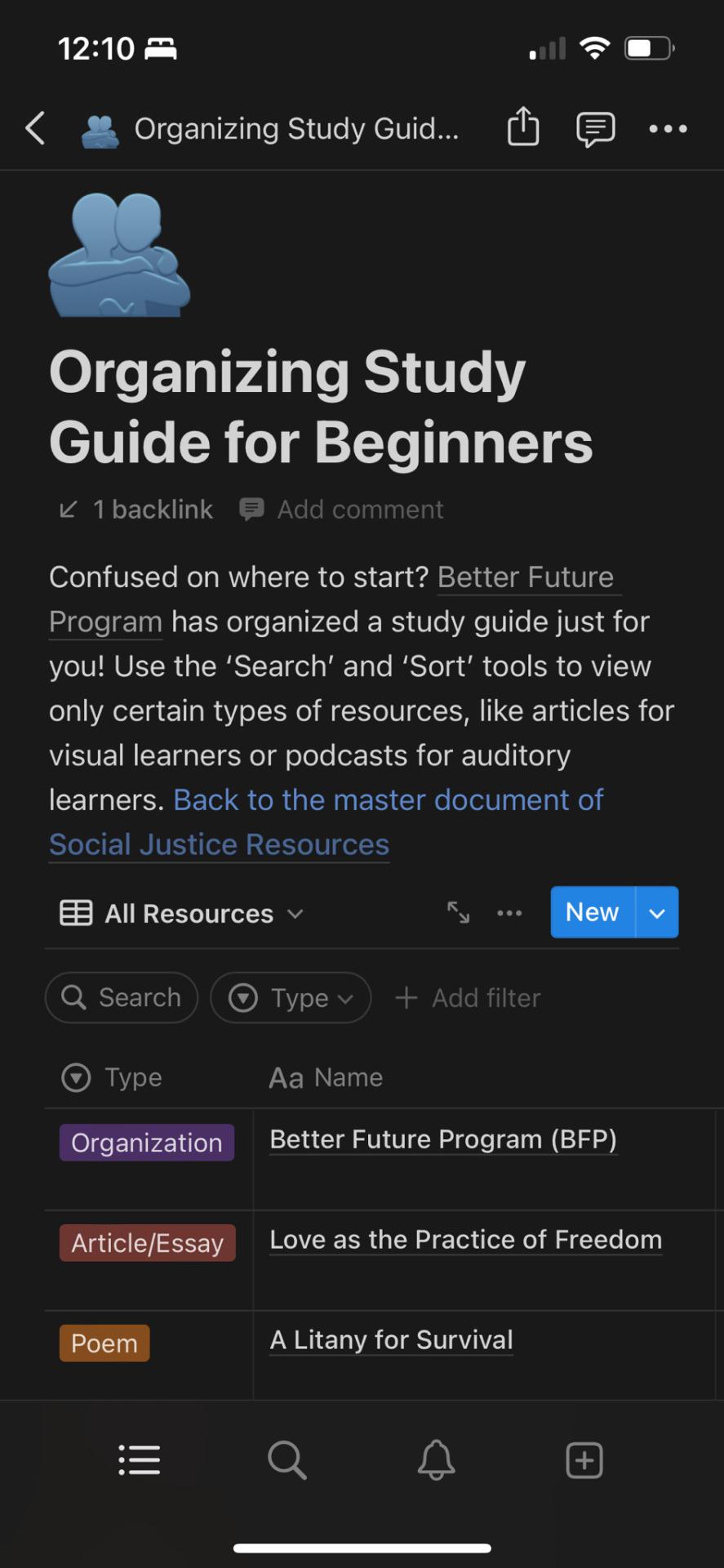

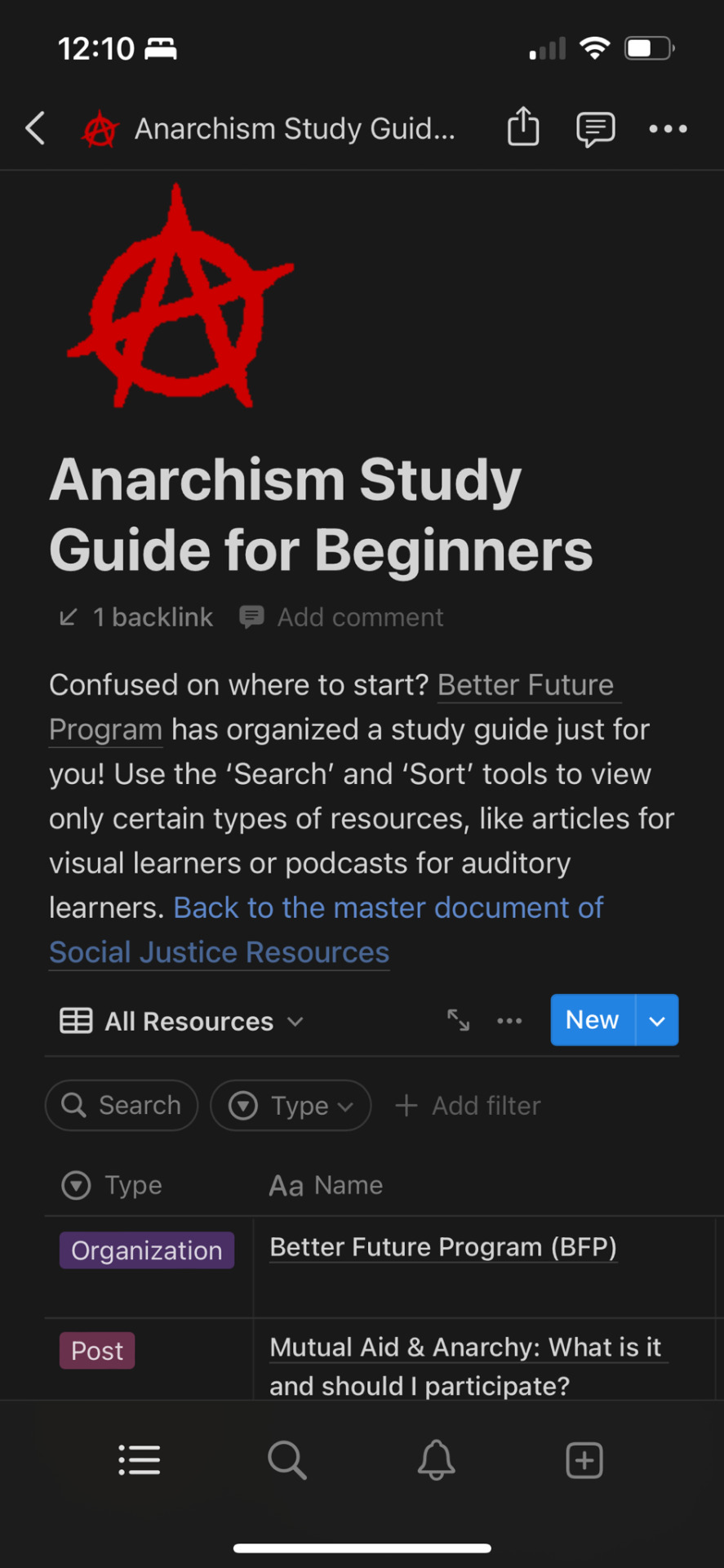
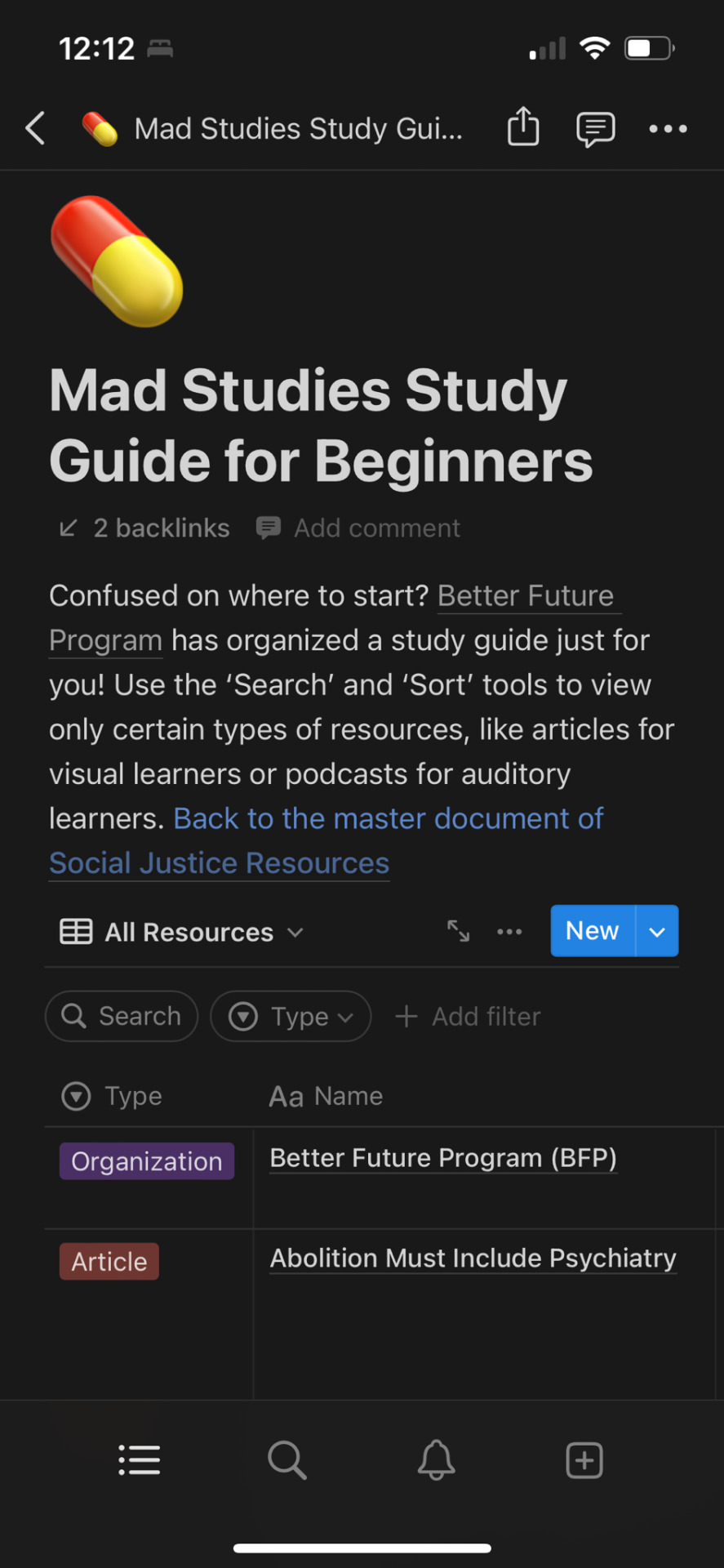
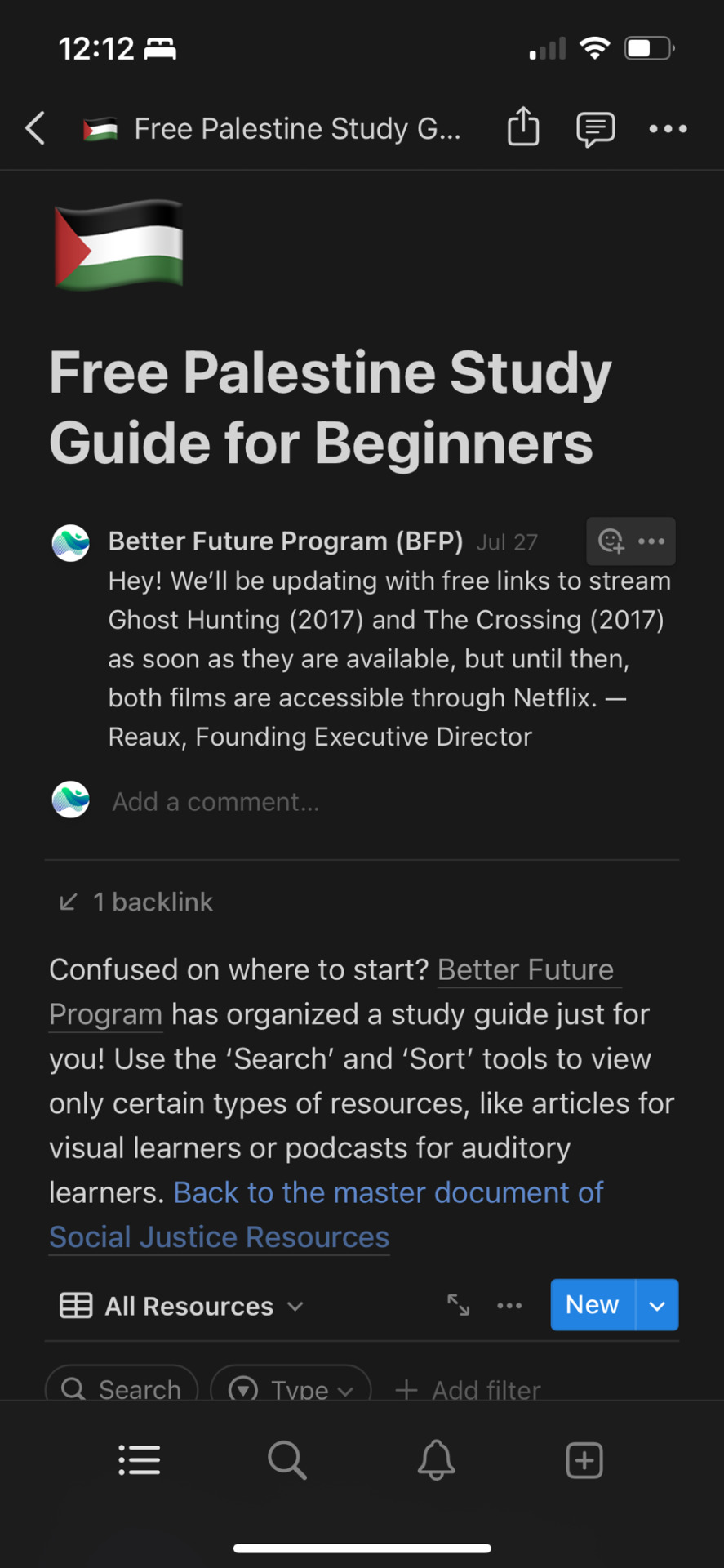
just wanted to remind everyone again not only of the 3,000+ resources offered through our Liberation Library but also of the study guides for beginners offered under each of our social justice topics!
resources can be organized by type (article, novel, podcast, video, etc.) as well as filtered and searched through. we’ve tried to make our system much more accessible than our former platform on google docs so this is such an exciting development to share with everyone.
please share to promote equitable access education!and if you’d like to volunteer with us, check out our open resources committee roles!
REBLOG THIS VERSION! image description by @bonesandblood-sunandmoon below the cut. thank you for writing one!
[Image Description: Six screenshots of beginner study guides on mobile view. The main text visible under each title reads:
Confused on where to start? Better Future Program has organized a study guide just for you! Use the ‘Search’ and ‘Sort’ tools to view only certain types of resources, like articles for visual learners or podcasts for auditory learners. Back to the master document of Social Justice Resources.
Five of the study guides have the start of a list of resources available with color coded resource types visible - Posts have a purple box, for example. Each study guide has an image. Prison/Policing Abolition has an image of chains, Organizing has two humanoid figures hugging, Classism and Anti-Capitalism has a stack of dollar bills, Anarchism has the red ‘A’ in a circle, Mad Studies has a yellow and orange capsule/pill, and Free Palestine has the flag of Palestine.
/End description.]
#reaux speaks#resources#educational equity#abolition#organizing#anti capitalism#anarchism#palestine#mad liberation#free palestine#israel
18K notes
·
View notes
Text
"The Biden era has normalized illness and demonized mitigations for the sake of “back to normal”. We now live in a country where educated liberals genuinely think it’s okay-and in fact good- that their kids are constantly ill (to be expected given the immune system-damaging nature of COVID). Where leftists argue that killing old people is less harmful than wearing masks. Where concern for community health is painted as cowardly and using the modern scientific tools we are lucky enough to have is portrayed as rude and stupid. And terribly, this liberal political project under Joe Biden has come down like a hammer on community solidarity, leaving “the vulnerable” squabbling with their mocking former comrades. It’s hard to overstate just how much damage the normalization of COVID has done to the very concepts of public health and community.
My beliefs throughout the pandemic have never changed: that vulnerable people deserve access to society, that mitigation must be prioritized, that great progress is possible with great effort, that community care is most critical in times of state abandonment. It’s hard to know where to go from here, at the nadir of a COVID response that vilifies and mocks any gesture toward prevention and care. But for those of us who are still here, education must start from a place of unpacking several years-worth of propaganda, while learning from disability justice activists who have reckoned with their social marginalization for decades.
Despite the multitude of falsehoods that continue to be poured over the heads of our comrades by outlets that can’t or won’t reckon with Biden’s failure, the truth has the advantage of being obvious, and patient. So we’ll continue to repeat it, until the people are ready to hear it: COVID is not mild. COVID is not harmless. COVID is not inevitable. COVID is not over. Stay safe out there."
#covid#eugenics#genocide joe#blue maga#death to america#genocide#wear a mask#queer cripple#anarchism#anticapitalism#ableism#anarchotahdigism#antifascism
348 notes
·
View notes
Text
actions 'should' have consequences?
If we are truly against punitive justice, then it is important to distinguish between 'actions have consequences' and 'actions should have consequences'.
'actions have consequences': just a fact.
"If you act like a dick, you will probably hurt people and those people will probably want to hang out with you less. If you agree that that is not a desirable result, I could help you figure out what motivates your dickish behavior and how that could change."
'actions should have consequences': a moral imperative.
"If you act like a dick, I will try to make sure that people hang out with you less because I think acting like a dick should have consequences and I think experiencing those consequences will make you change your behavior".
This is punitive justice. The consequences are the punishment and we expect change to come after the punishment or to avoid the punishment.
This gets one step worse when it's put into practice by people who are against the aesthetic of punishment (prisons, physical punishment, rulings etc) but who nonetheless believe that actions should have consequences, because the one tool they have at their disposal is the informal practice of exclusion. When exclusion becomes the consequence for every bad action, you're just constantly tearing off and throwing out bits of your community while wishing you could have a community that doesn't practice punitive justice.
The phrase 'actions should have consequences' often comes up when someone with power and privilege avoids punishment within the punitive system. In that context, what it's saying is "If you're going to punish killers, punish the cop that kills people. If you're going to punish tax evasion, punish the rich guy, etc.".
What it's doing there is pointing out the hypocrisy of the punitive system. But we should remember that and not take 'actions should have consequences' and try to incorporate it into our own non-punitive concepts of justice. It is fundamentally a punitive concept.
723 notes
·
View notes
Text
“The ‘war on drugs’ may be understood to a significant extent as a war on people. Its impact has been greatest on those who live in poverty, and it frequently overlaps with discrimination directed at marginalised groups, minoritiesand Indigenous Peoples. In our reporting and experience, we have found that such discriminatory impact is a common element across drug policies with regard to the widest range of human rights, including the right to personal liberty; freedom from torture, ill-treatment and forced labour; fair trial rights; the right to health, including access to essential medicines, palliative care, comprehensive drug prevention and education, drug treatment, and harm reduction; the right to adequate housing; freedom from discrimination and the right to equal treatment before the law; right to a clean, healthy and sustainable environment; cultural rights and freedoms of expression, religion, assembly and association.
Globally, drug control has had massive costs for the dignity, humanity and freedom of people of African descent, with reports showing that people of African descent face disproportionate and unjust law enforcement interventions, arrests and incarceration for drug-related offences. In various countries, the ‘war on drugs’ has been more effective as a system of racial control than as a tool to reduce drug markets. Policing interventions based on racial profiling remain widespread, whilst access to evidence-based treatment and harm reduction for people of African descent remains critically low.
Around the world, women who use drugs face significant stigma and discrimination in accessing harm reduction programmes, drug dependence treatment and basic health care. Although one in three people who use drugs are women, women constitute only one in five people in treatment. Women are also disproportionately affected by criminalisation and incarceration, with 35% of women in prison worldwide having been convicted of a drug-related offence compared to 19% of men. The causes of women’s interaction with the criminal justice system in relation to drugs are complex, often linked to other factors such as poverty and coercion, and may reflect systemic gender inequality in society more broadly. Of note, most women in prison for drug related offences have little education.
Under international law, States that have not yet abolished the death penalty may only impose capital punishment for the ‘most serious crimes’, meaning crimes of extreme gravity involving intentional killing. Drug offences clearly do not meet this threshold. However, drug-related offences are still punishable by death in over 30 countries, and human rights experts have raised concerns about evidence of its discriminatory impact on individuals belonging to minorities.
Everyone without exception has the right to life-saving harm reduction interventions, which are essential for the protection of the right to health of people who use drugs. However, according to UN data, only 1 in 8 people with drug dependence have access to appropriate treatment, and the coverage of harm reduction services remains very low. The situation is particularly critical for women, LGBTIQ+ persons, and other marginalised groups, for whom harm reduction and treatment services may not be adapted or respond to their specific needs. Women and LGBTIQ+ persons also face even higher levels of stigma, including self-stigma, and discrimination than men who use drugs.
As the world grows older, drug use among people over 65 has also increased. The COVID-19 pandemic had a negative impact on the health and well-being of older persons, and studies show an increased use of pain relievers, tranquillizers, and sedatives among this age group. Older drug users are also more often using the dark web, social media, and online forums to obtain illicit substances resulting in a rise of drug-related deaths among older populations.
The criminalisation of substances traditionally used by Indigenous Peoples such as the coca leaf can also result in the suppression, undermining and marginalization of traditional and indigenous knowledge systems and medicine, which has wide-ranging health impacts and is rooted in discriminatory hierarchies and conceptions. Forced eradication of crops, including through the aerial spraying of highly hazardous pesticides, can cause serious harm to the environment and clean water, as well as to the health and welfare of Indigenous communities. Indigenous Peoples that might be affected by these and other drug control operations must be meaningfully consulted, and guarantees should be given that their lives, cultural practices, lands and natural resources are not violated.
Criminal laws and the punitive use of administrative and other sanctions stigmatise already marginalised populations. Criminalisation results in significant barriers to access to health services (including those for HIV and palliative care) and in other human rights violations. As called for by the UN system Common Position on drug-related matters, drug use and possession for personal use should be decriminalised as a matter of urgency. Drug use or dependence are never a sufficient justification for detaining a person. Compulsory drug detention and rehabilitation centres need to be closed and replaced with voluntary, evidence-informed, and rights-based health and social services in the community.
736 notes
·
View notes
Text
Alright fuck it I want to ramble analyze characters more. I've been stuck on who so I opened to a random page. Saw Marasi first and now I am going to see what things my brain will inform me about her as I write this post.
Spoils for Era 1 and 2 of Mistborn
I've seen Marasi compared to Vin, both in the text and in some posts online, but let's take another angle.
In Mistborn if I asked you which character
Is the socially inconvenient child to an upper class house
Has a half-sibling that gets romantically involved with the main protagonist
First bonds with our earring wearing protagonist at a high society function
Has an education that leads them to believe they can fix the whole world if you just let them do it
Oh my gosh it's Elend Venture in a wig!
But now that I think about it, there is a lot of similarities between Elend and Marasi beyond surface level plot.
Marasi and Elend of course share the traits mentioned above but also share a similar problem. Theory works in theory, practice doesn't always work in practice.
Both of these characters would achieve far greater success if they just didn't play by the rules they said everyone should agree to on the basis they know better.
However while Elend relents at the end of his era, becoming a mostly benevolent tyrant.
Marasi gives up her opportunity to circumnavigate her rules. She rejects the offer to join the Ghostbloods. An organization she could likely do far more with than any regular position within The Basins policing system would ever afford her.
Now in Wax's epilogue we find out she's running for Governor, which would give her greater ability to enact her reforms but she is still working within the system, which realistically will greatly limit her ability to solve problems. (Although I'm sure come Era 3 we'll find out she did plenty of good for the people of Scadriel.)
I mentioned previously that Wayne is toxic preservation while Wax is literally stated to be a force of ruin.
In this view I would see Marasi as Harmony. Unlike Sazed, who is Harmony due to his duplicitous (but not decietful) nature, Marasi is a true balance.
Rusts I feel like I said very little with too much in this post? OH FUCK HER ALLOMANCY!
Umm fuck, Marasi probably has symbolic traits tied to her Allomancy let's see.
You could argue that it plays into how slowly she feels like she grows, that everything can happen so fast around her and that if she was only given the right tools (allomantic grenades) her skills would become invaluable?? Idk I probably should make another post about her sometime. Feels like I didn't do her justice here haha
#cosmere#mistborn#mistborn era two#mistborn era 2 spoilers#nuzzy reads#mistborn era 1#elend venture#marasi colms#analysis#character analysis#rambling#rambalysis#fuck thats a good name#going to try and call this Rambalysis now
80 notes
·
View notes
Text
[“Listen to me: It is not gauche to write about trauma. It is subversive. The stigma of victimhood is a timeworn tool of oppressive powers to gaslight the people they subjugate into believing that by naming their disempowerment they are being dramatic, whining, attention-grabbing, or else beating a dead horse. By convincing us to police our own and one another’s stories, they have enlisted us in the project of our own continued disempowerment.
Believe me, I wish this horse was dead. Take a few of many, many such statistics in a grossly underreported set of crimes: the National Intimate Partner and Sexual Violence Survey recently found that 13.1 percent of lesbians, 46.1 percent of bisexual women, and 17.4 percent of heterosexual women have been raped, physically assaulted, or stalked. According to RAINN (Rape, Abuse & Incest National Network), an American is sexually assaulted every sixty-eight seconds, and one in six women the victim of rape or attempted rape. TGQN (transgender, genderqueer, nonconforming) students are more often sexually assaulted than non-TGQN students. Indigenous Americans are twice as likely to experience a sexual assault as an American of any other race.
Just as the justice system was not designed to protect or enact justice for all (and often was designed to protect those with the most power from their harms against those with less), the values of literary publishing were not designed to support or promote all stories. This has been shifting in recent years, but I have learned not to overestimate the speed of institutional change. A little bit after a long time of nothing can be easy to mistake for more than it is. Still, the dominant culture tells us that we shouldn’t write about our wounds and their healing because people are fatigued by stories about trauma? No. We have been discouraged from writing about it because it makes people uncomfortable. Because a patriarchal society wants its victims to be silent. Because shame is an effective method of silencing.
I used to scoff at memoirs and I was embarrassed to admit that I had started writing one. It was a serious book, I insisted regularly, not only concerned with my experience but with ideas. Now, this practice strikes me as similar to how, as a lifelong feminist who prefers sex and partnerships with women, I have been insisting for my entire life that I’m not an angry man-hating lesbian. That I hate the systems, not the people. Of course I do not hate every man. The very fact that I, and so many women, are compelled to incessantly reassure them of this is more evidence of our continued oppression.”]
melissa febos, from body work: the radical power of personal narrative, 2022
73 notes
·
View notes
Text
BY ALLISON TOMBROS KORMAN
As the war ramped up, it was clear that this issue was not going away. Not only was I struggling to process Oct. 7 with friends, family, and my community, I was also navigating the conflict every day at work. As the only Jewish voice in the organization, I was repeatedly put in the position to speak for all Jewish people—an impossible task—or to defend my perspective and why it did not align with that of Jewish Voices for Peace, a group that purports to represent Jews but rejects the basic premise of a Jewish homeland, or similar entities. At the same time, if I advocated for DCAF staying out of this discussion, I was told I was silencing the organization and its staff. I shared my heartbreak about the violence against both Israelis and Palestinians and how, though complex, these feelings could coexist. In return, it was explained to me, often by people with no direct connection to the land or its people, that I needed to understand “context.”
At the same time, other abortion funds and reproductive health organizations began issuing statements about what was happening in Gaza. These statements contained much of the same offensive nomenclature as DCAF’s draft and some, like ARC-Southeast’s letter, went further, calling Zionism—the belief that Israel simply has a right to exist—“a contradiction to Reproductive Justice.” Every member of the DCAF staff except me signed on to a letter to the board advising them that they would be participating in a walkout in support of Palestine. The letter noted, “We are using our collective power as DCAF workers to show up for Gazans and call for an immediate ceasefire, as well as liberation for Palestinians ... we cannot ignore the mass violations to human rights and sexual and reproductive health outcomes that we’re seeing out of Gaza.” Remarkably, the letter neglected any mention of health outcomes for the Israeli survivors of rape or assault, or for the hostages.
In an effort to work collaboratively and keep focused on our primary objectives, we agreed that establishing social media procedures was a critical next step. On Nov. 14, I and the communications team sat down to decide what, if anything, DCAF would be posting about the war and to ensure there were not more situations like that which occurred around the “Gaza Carousel.” I recognized that my colleagues felt strongly that DCAF should weigh in on this discussion, and in an effort to compromise, I agreed to a process that would allow DCAF to uplift existing content from trusted partners in the field, but not create original content, as this would be beyond our expertise. We agreed to abstain from using nomenclature that could be distracting or divisive to our community, such as the “Free Palestine” hashtag or calling Israel’s actions “genocide.” We developed a system to review and discuss potentially controversial content related to the war before posting, starting with a small group of reviewers, including me, and escalating to a vote by a mix of board and staff.
The following morning, I circulated the notes from that meeting to DCAF leadership and members of the Board. At 3 p.m. that day, I was alerted by a Jewish DCAF volunteer that the DCAF Instagram feed featured graphics from The Washington Post about deaths in Gaza with commentary overlaid, specifically that “collective punishment is the tool of fascists” and that what was happening in Gaza was “a prime and top-of-mind example of said collective punishment.” I immediately flagged this for the communications team and asked if perhaps the content was posted inadvertently since it violated the norms we had established in the meeting the previous day. Surely, equating the actions of the entire State of Israel with fascism was a perspective that needed to be discussed as potentially controversial. They assured me the post was intentional (they later stealthily removed it).
Immediately, DCAF received angry messages from Jewish members of their community. The messages criticized DCAF for being so one-sided on the issue. They were furious that DCAF, who claimed to deeply value reproductive justice, had remained silent on the rapes of Israeli women. They stated that as Jews, they felt abandoned by and isolated from the organization.
33 notes
·
View notes
Text
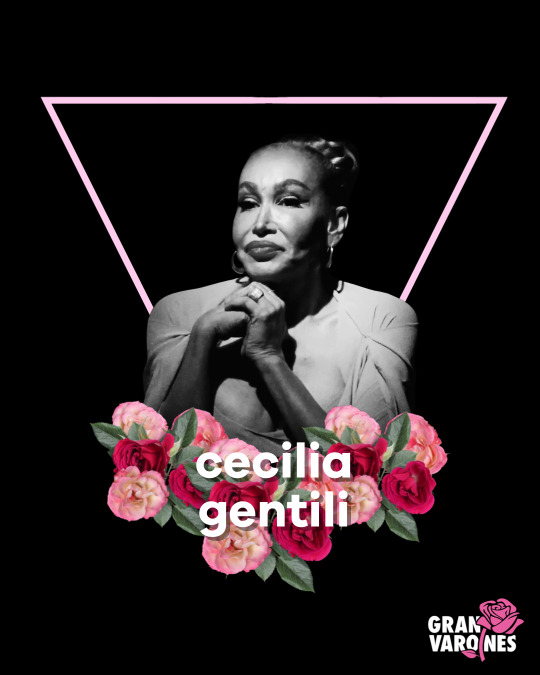
Cecilia Gentili was a trans activist.
Cecilia Gentili was a mother.
Cecilia Gentili was a friend.
Celicia Gentili was an icon.
Celicia Gentili was here.
Cecilia navigated an often unkind world with a disarming and empowering grace. Her journey from Argentina to the heart of New York City was not merely a search for sanctuary but a quest to make the invisible seen, the silenced heard, and the marginalized celebrated. Her activism was her art, and her art was a form of activism. Cecilia painted vivid pictures of resilience, struggle, and triumph through her storytelling. She brought to life the experiences of the trans community, advocated the decriminalization of sex work, and supporting those living with HIV/AIDS. Cecilia's voice was a clarion call for justice, echoing in the corridors of power and the streets, demanding change, equity, and love.
Cecilia was a force.
Cecilia's legacy is not only in the many movements she helped shape or the policies she influenced, but also in the lives she touched. She mentored many, sharing her wisdom, warmth, and wicked sense of humor, oh so generously. To be loved by Cecilia was to be seen in your entirety, embraced for who you were, and inspired to become who you might be. I know this from personal experience. Her capacity for love was boundless, and she gave it freely, fiercely, and without reservation.

Cecilia was a healer.
Like her activism, her art reflected her soul—bold, beautiful, and transcendent. Cecilia used her creativity as a tool for advocacy; her performances and storytelling were not just entertainment but powerful statements on identity, society, and the human condition. Through her art, she challenged systems, questioned injustices, and oriented communities in the discipline of hope.
Cecilia was a teacher.
Cecilia Gentili leaves behind a world forever changed by her presence. She showed us that change is possible, that love is powerful, and that living one's truth is the ultimate form of resistance. Let us honor her memory by supporting one another with compassion, living our truths, and building the world she knew we all deserved.
Cecilia is now an ancestor.
Rest in power, Cecilia. Your journey here has ended, but the love you left us is everlasting. We love you, miss you, and will never forget you.
37 notes
·
View notes
Note
hey there! I'm not sure whether this has been asked before or not, but I thought I might give it a try nonetheless.
what are the main differences between the TdM system and the RWS one, if there are any, in your opinion?
I'm looking forward to writing a blog about it, so I'm trying to gather as much information from as many people as possible. thanks beforehand!
Hi there! Thank you for asking and GOD I hope I'm late because I've been thinking non-stoping about this for the last days just to give you a complete answer. You have no idea how happy I'm to contribute with some firewood to the good ol' war between decks hashahsa.
For me, the biggest difference between both decks and schools of thought is that the RWS Tarot can BARELY be considered a tarot deck (and this is not necessarily a bad thing).
It's a "tarot" in the same way that Taco Bell's "tacos" are tacos. Technically they are and I can't say anything about it but when you compare them with authentic tacos you realize there are enormous issues in their construction, their ingredients, their history and the culture around them.
They are perfectly """edible""".


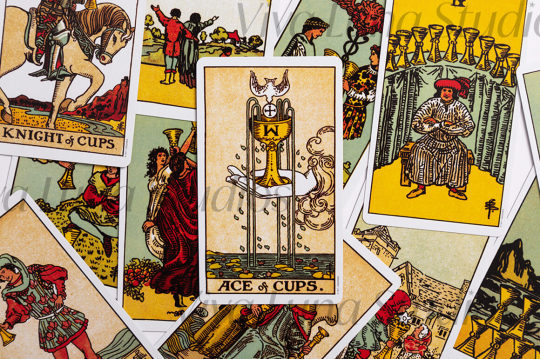
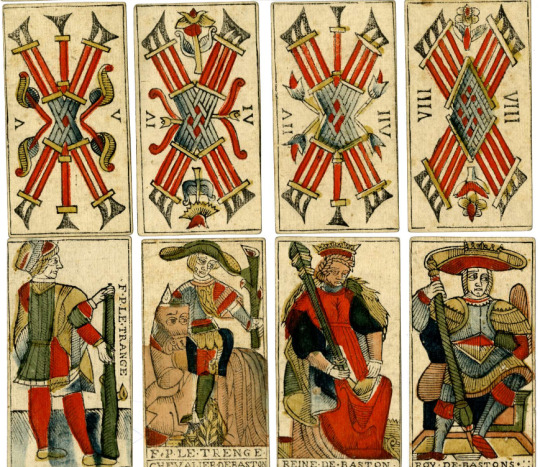
Now, I'm the first to admit it, Pamela and Arthur's deck changed not only cartomancy but the perception of the entire world around it. Pamela's exquisite artistry and innovative idea of illustrating the minor arcana made it BY FAR the most important tarot deck of all times. HONOR TO WHOM HONOR IS DUE. And as cartomants we owe respect to the deck (and its creators) for literally bringing cartomancy into modernity. It is directly responsible for the fact that we are discussing this topic today and for all the extraordinary artistic madness of hundreds and hundreds of new decks that are printed and designed.
HOWEVER. The deck has HUGE and unacceptable errors that split the modern study of tarot into two and a thousand pieces, but I have to give their case justice. Arthur Edward Waite and Pamela Colman Smith were members of the Golden Dawn and their plan was to create a tarot deck with the ritual, sacred and symbolic associations of the order.
Is it their fault that their niche deck escaped containment? Of course not. We are used to working with luck, it is our territory, so it's no surprise that the mass popularization of tarot (and this deck in particular) came with an equally destructive counterpart. I can't blame them, Geek culture (and fandom in general) has to live every day with the Horrors and Pleasures of seeing their niche content, intended for a few, be dismembered and multiplied in the hyper-globalized sphere of "normie" culture.
I'm in several tarot groups on Facebook and the question every day is: What is the best deck for beginners? And the truth is that I don't know what to answer.
I have read with both systems and right now, my little TdM is my tool par excellence. I admit that the "dry" art of the minor arcana and the deck in general is an acquired taste. There are such beautiful and impressive decks out there that I completely understand why not many decide to stick with the tarot world's equivalent of vanilla triple condom missionary sex (although this is an aesthetic issue that is being called into question with new decks).
What I don't understand is the conception that the Marseille tarot is more complicated than the RWS!
If the TdM school is characterized (or could be characterized, I curse you Jodorowsky!) by austerity and lack of expressiveness, the RWS school is characterized by paranoia and the pseudo-complexity of symbols and structures.
By "paranoia" I mean the obssesive search for hidden meanings or mystical secrets and messages. Usually where there are none.
Reading with an RWS deck for the first time is a horrible experience and we are very much to blame for scaring away beginner readers. Assuming that you have survived the countless myths that all decks carry (it must be a gift, it's satanic, don't read on Sunday) you realize that you don't know how to read it. Each of the 78 cards has a different scene and all of them are full of symbols. What do the pomegranates on the High Priestess' veil mean? What the fuck is a High Priestess? Why do some cards have names and others don't??? It is an aggressive sea of information that ends up drowning anyone.
But that is not all! Now comes the plot twist and it turns out that not only you have to learn 78 meanings (in equally confusing websites or books) but that each card has a different meaning in reverse. 156 cards in total, each with a series of extensive meanings for love, family, work, money, health, etc. And as if that weren't enough, the spreads look like this:

Where each of the positions has an extra layer of meaning. This is not a specific problem of the RWS but we have long since passed that point, we only have to manage the disaster that its globalization carried.
The big problem with RWS and its school of thought is that in the process of making a more intuitive tool, it became a creature that feeds on the paranoia of its readers. It is an excellent deck to spread on the table and read lightly: The faces and situation of the characters are clear, the art is friendly and reading is easy. A 10 of swords is an obvious image of failure and pain, the 3 of cups inspires joy and suggests party and friends. It is a tool that fuses the allegorical advantages of a classic tarot deck with the everyday fluidity of a sibyl or an oracle. It has nothing to envy an Italian Sibyl or a Kipper deck.
It is human, intuitive and beautiful.
The problem comes when we want to extract more of it. Being a ritual deck, it is impregnated from top to bottom with numerological, astrological, Hebrew, Egyptian, etc. associations of magic and occultism derived from the not very convincing knowledge of the GOLDEN DAWN. It was not intended to be a deck for common and mundane divination use.
The average casual cartomancer knows the meanings of the cards because they read them on a website (and hopefully in a book/video). Most people don't know who Pixie or Arthur Waite is and probably haven't read any of their original texts. What's worse, there's a good chance you're not a member of the Golden Dawn and you also don't know that previous decks exist. All those symbols and associations that served an original purpose become a mental burden when reading with it.
What good does it do me to know that the coins in the 10 of coins represent the Tree of Life or that the Magician transfers the energies of the High to the Low, alluding to one of the magical premises of the Tabula Smaragdina ("As above, so below") when what I want to know IS IF MY EX WOULD GET BACK TO ME???
A lot of information but useless information. And that's still the best case scenario. At worst…
The incomplete fusion of poorly understood mystical allusions, an intuitive deck loosely anchored in classical cartomancy and the whitewashed psychology of the New Age in search of alternative therapies gave birth to a monster: EVOLUTIONARY TAROT. (But that's another story. The evolutionary tarot isn't really bad in its conception, but the road to Hell is paved in good intentions ahhasha. I have already a post about it).
If the RWS school got rid of the complicated spreads, the reversed cards, the useless lists of meanings, the obsession with symbols and FOCUSED on Pixie's illustrations and read Arthur's original texts it would be easier to use its tool without losing their marbles in the process, but that is going against the current and not analyzing the existing reality.


By illustrating the minor arcana, the deck became more friendly but in exchange it lost the hierarchy of the major arcana. In the image there are 3 major and 3 minor arcana, but visually they have the same weight and therefore, the same relevance when this SHOULD NOT HAPPEN. The Sun cannot be on the same level as a 10 of Swords no matter how bloody the card is.


Another situation: Let's focus on the Wheel card. I already made a post about it that you can find on my blog, but in summary there is a HUGE difference between this arcane in the RWS and the TdM. Which is saying a lot when the TdM's Wheel is itself extremely defective.
If the RWS tarot does not respect the hierarchy of the arcana, many of them are "badly" represented, or at least incomplete without the contribution of Arthur and the Golden Dawn, it does not have a divinatory purpose and illustrates its minor arcana based on external sources such as Etteilla, numerology, astrology, etc… CAN WE CONTINUE CONSIDERING IT A TAROT?
I suspect not and this is not a bad thing. On the contrary, it has an extraordinary place as a multipurpose oracle that could be developed more freely without the pretension of wanting to be (without actually being) a tarot deck.
And yet, the Marseille tarot is the one that has the reputation of being MOST COMPLICATED!!!???
As I said before, honor to whom honor is due and therefore, dishonor to whom dishonor is deserved ahsahsa. Alejandro Jodorowsky did an enormous job to popularize the TdM deck but he missed a VERY SMALL detail like other important tarot figures such as Papus and Eliphas Levi:
The PARANOIA.
I love you friends, but if I hear someone say again that the Tarot of Marseille holds mystical secrets in its geometry, I'm gonna kill someone ahsahsa. ENOUGH, for mercy's sake! Many beginners infected with the mystical paranoia of the RWS come to the classic decks with the same perception of hermetic and conspiratorial symbology, which is fueled by the LITERAL search for easter eggs and hidden meanings popularized by the aforementioned characters. Sometimes two cups are TWO CUPS and 3 swords are THREE SWORDS. There are no secret codes involved but who seeks finds and sooner or later you will end up paying more attention to the leaves on the decorations or the color of the shoes than to the FUCKING CARD ITSELF.
This manifests, for example, in another of the major problems that both systems share:
CUPS ≠ WATER
WANDS/BATONS ≠ FIRE
COINS ≠ EARTH
SWORDS ≠ AIR
REPEAT AFTER ME: SUITS ARE NOT ELEMENTS.
Many readers tend to automatically replace the objects in the cards with the later elemental associations. When we see 6 swords in a classic deck, we are not talking about air, MUCH LESS about the meaning that Etteilla or Arthur Waite gave to the card. 6 swords are more swords than you want your enemy to have and since they are swords and not AIR, their function is simply to cause you a lot of damage and pain. Bad omen.
THERE IS NO MYSTERY.
We can add another layer of information, helped by numerology and adjacent cards, but we must never lose sight of the SUPERIOR hierarchy of this obvious and clear message in favor of DETAILS such as the ornaments and the distribution of the swords on the card.
The biggest danger of the RWS system is being overloaded with useless information and ridiculously complicated systems. The biggest danger of the TdM system is not seeing the MESSAGE by focusing too much on absurd details.
The Marseille tarot has MANY flaws as it is a poor copy of Italian decks. Curiously, its situation is almost identical to that of the RWS. By reaching a globalized impression in Europe, the forgivable mistakes of a niche deck spread far and wide. Even so, it preserves the characteristic simplicity of classic decks: You can perfectly distinguish a major arcana from the rest and give it the place it deserves in a reading. The allegories have errors but they maintain a clear and understandable representation for the most part (I also have a post about it).
Many TdM readers do not use inverted cards and free reading on tableaus and strings are the favorite. If we ignore the symbolic paranoia of various authors, focus on the cards in front of us and their allegorical meanings, we have a VERY EASY TO READ tool. It is not as comfortable or friendly as a RWS but it is definitely more free and concrete. Less noise, less chaos. Straight to the point.
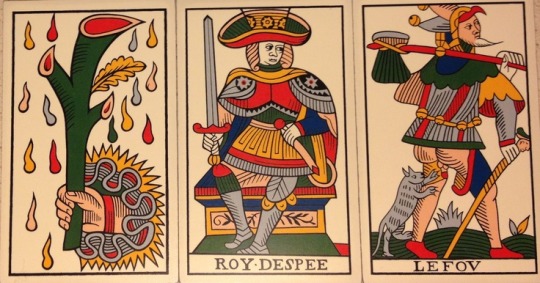
I'm not going to lie to you either, anyone who has used a TdM knows that no matter how skilled the reader is, the deck cannot be compared to a sibilla or the RWS when the topic is everyday and mundane divination. It is a dry, direct deck, but little theatrical or gossipy compared to other decks. In the same way, if we ask a sibyl complex and imaginative questions we will have the same result as if we asked the vegetable seller at the market.
Much of the debate comes down to knowing what your need is and your appropriate tool.
In conclusion:
I think the RWS system is unnecessarily complicated, which undermines its great advantage: Being able to read the deck intuitively without having to study it. I think that if it completely abandoned its desire to be a tarot and became an independent deck of illustrations, it would be an exquisite oracle.
The TdM is not the sharpest knife in the arsenal of classic decks, but it is a very easy tarot deck to learn and use if we ignore the symbolic paranoia and limiting meanings of some authors. It is (like all classic decks) a deck with the limitations of tarot, so instead of forcing it to answer all the questions, sometimes it is better to know when to use another oracle.
28 notes
·
View notes
Text
I spent 15 hours, across three days, watching and taking notes on the legal proceedings at the International Court of Justice, where South Africa filed a genocide case against Israel.
South Africa's case was a temporal snapshot that lay the weight of decades of historical context. Although the specifics of the case pertained to Israel's actions in Gaza, its overarching objective reached beyond these particulars. At its core, the case sought to address the substantial disparity between the lived reality of Palestinians and the narrative propagated by dominant political forces.
Across the globe, public anger regarding the events in Gaza has manifested on the streets. However, political leaders consistently chose to overlook, dismiss, ban, or vilify this collective sentiment. Maybe it is recency bias, but in my lifetime, there has never been such a disconnect between politicians and their people than when it comes to Gaza.
The significance of South Africa's case before the International Court of Justice is that it publically challenges the portrayal of the Palestinian cause as a fringe issue.
Beyond merely outlining the severity of events – 23,000+ killed in Gaza, the 1.9 million displaced, the 7,000+ missing under the rubble, and the thousands of bombs dropped, making this the deadliest rate of conflict of the 21st century – the case links these claims to the Geneva Conventions and human rights law.
But where are we as a society, as a human race even, that we are at a point where the case was brought forth in the first place? Such an initiative questions the legitimacy of the international response and underscores the diminishing persuasive power of Western logic in an increasingly multipolar world.
The case represents a broader confrontation within international institutions, raising doubts about the actual existence of the human rights infrastructure. The conflict has placed Western allies in the precarious position of undermining or neglecting their own established systems, eroding their credibility on the global stage. When you're against the United Nations and hundreds of human rights organisations and objecting to a submission in a global court (in the case of the US and UK, a court that they themselves established), you are simply pulling apart your house with the very tools that built it.
Western powers, having previously failed to support a Gaza ceasefire, will from now on be viewed in the global south as fighting on Israel's side. More so than they were already. And why wouldn't they be? These politicians have made it clear that they want to supply arms and military support to a regime, and their intervention, it seems, is contingent upon the safeguarding of goods shipment. These politicians assert that financial resources are lacking for reconstructing their nations, yet readily allocate funds for military endeavours. Why? How is any of this normal?
After the legal proceedings, Netanyahu said, "We will continue the war in the Gaza Strip until we achieve all our objectives. The Hague and the axis of evil will not stop us." Without compelling a policy change from Israel, what hope is there that South Africa's case will avail? It was obvious that Israel would use support from the US and the UK to prosecute the real agenda that Netanyahu and hundreds of Israeli politicians have hidden in plain sight (i.e. admitted on camera constantly): the destruction of Palestine and its people.
The recurring pattern is evident. Gaza transforms from an open-air prison to an open-air slaughterhouse under Israeli actions. Iraq faces invasion and fragmentation fueled by falsehoods and lies. Libya, once somewhat stable, descends into a state of civil war. Afghanistan witnesses invasion followed by prolonged failure and abandonment. Yemen endures relentless bombing, culminating in one of the most severe humanitarian crises in recorded human history. Syria? Also bombed, resulting in the displacement of thousands of refugees.
All of this, and more, is the legacy of Western "intervention", war, and policy in the Middle East.
Strangely, I find myself distanced from all this turmoil, yet the impact remains surprisingly profound. So many people I love have been impacted, yet I still experience a sense of detachment.
I go about my life. I have family and friends. I have hobbies and a job. But multiple times a day, it will hit me. I'll remember the videos I've seen of a mother crying over her son's body. Or the father carrying the remains of his children in plastic bags. Or the doctors performing amputations in overcrowded hospitals with nothing more than a dull butter knife. A wave of deep sorrow washes over me, settling in my chest like a persistent ache, lingering until I find a sufficiently absorbing distraction. And then, the cycle restarts.
But I don't want to be distracted. And I don't want to forget. I feel like I don't deserve to forget. It feels like the least I can do. Because I, unfortunately, do not have a megaphone loud enough to shout to those in positions of authority and tell them they are cowardly individuals sitting on chairs fashioned from the bones of Gaza's children.
In 2024, you would think that we would only be quoting Martin Luther King to learn about history and not to still use his message for current happenings, but he honestly said it best: "No one is free when we are all free."
32 notes
·
View notes
Text
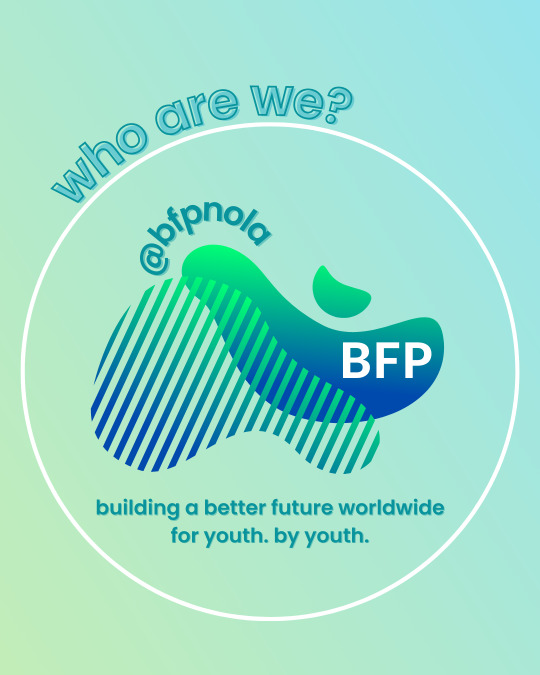
ID by our volunteer Wren: all slides have a background of a pale green-yellow to light blue gradient. The first slide is titled "who are we?" in light blue text with a thin dark blue outline. The title follows the curve of a large white ring in the center of the slide, which circles BFP's logo. Inside the ring and below the logo, blue text reads "building a better future worldwide for youth. by youth." End ID.

ID: all slides except the first have a dashed-line white border around the slide. the second slide is titled "welcome!" in blue text on a white rectangle. the rest of the slide has blue text on a white background that reads, "hey! we're better future program (BFP)! founded in 2016 in bulbancha (so-called new orleans, louisiana, usa), we are an entirely youth-run registered nonprofit [globe emoji]
our mission is to globally expand peer-led political education, support, and imagination for marginalized youth!
we actually achieve this goal through offering 3,000+ free resources through our liberation library, providing 60+ youth with the leadership roles and tools to host their very own social justice teach-ins, 24/7 peer support through our discord server, mutual aid-based fundraising campaigns, and so much more to come! [speaking emoji].” in the bottom right corner, the number 1 is circled. End ID.
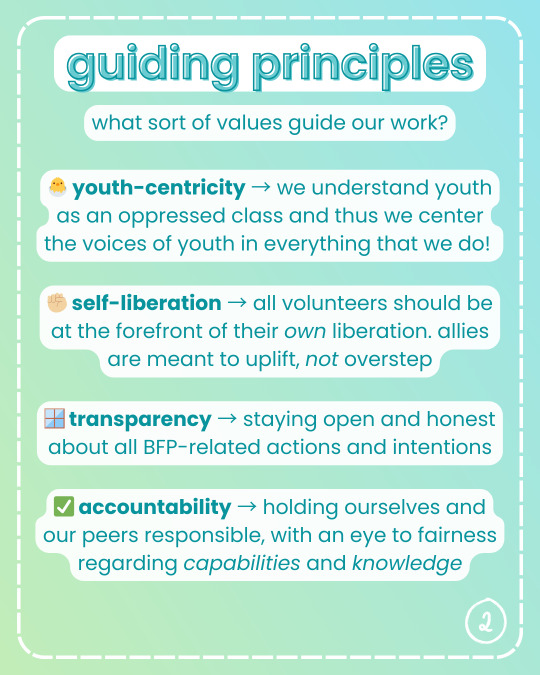
ID: the third slide is titled "guiding principles" in blue text on a white rectangle. the subtitle reads "what sort of values guide our work?" in blue text on a white rectangle. the rest of the slide has blue text on white backgrounds which reads, "[chick emojil youth-centricity [arrow] we understand youth as an oppressed class and thus we center the voices of youth in everything that we do!
[fist emoji] self-liberation [arrow] all volunteers should be at the forefront of their own liberation. allies are meant to uplift, not overstep
[window emoji] transparency [arrow] staying open and honest about all BFP-related actions and intentions
[check emoji] accountability [arrow] holding ourselves and our peers responsible, with an eye to fairness regarding capabilities and knowledge". in the bottom right corner, the number 2 is circled. End ID.

ID: the fourth slide is titled "guiding principles" in blue text on a white rectangle. the subtitle reads "just a few more! keep going!" in blue text on a white rectangle. the rest of the slide has blue text on white backgrounds which reads, "[equal sign emoji] horizontality [arrow] valuing the decision-making abilities of our volunteers and thus, fostering power alongside one another rather than over each other
[hug emoji] community [arrow] valuing the impact of a shared story, collaboration, and an effective, non-carceral support system
[woman emoji] intersectionality [arrow] recognizing how various aspects of a person's social and political identities combine to create different modes of discrimination and privilege". in the bottom right corner, the number 3 is circled. End ID.
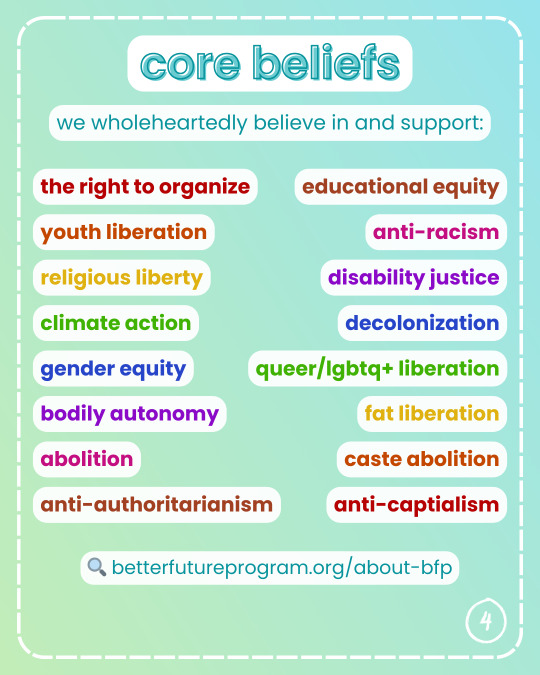
ID: the fifth slide is titled "core beliefs" in blue text on a white rectangle. the subtitle reads "we wholeheartedly believe in and support:" in blue text on a white rectangle. the rest of the slide's text is a list, starting with red text at the top, with each list item changing to another colour of the rainbow until the list ends with red again.
The list reads: "the right to organize, youth liberation, religious liberty, climate action, gender equity, bodily autonomy, abolition, anti-authoritarianism, educational equity, anti-racism, disability justice, decolonization, queer/lgbtq+ liberation, fat liberation, caste abolition, anti capitalism.”
at the bottom of the slide, blue text on a white background reads "[magnifying glass emoji] betterfutureprogram.org/about-bfp". in the bottom right corner, the number 4 is circled. End ID.

ID: the sixth slide is titled "our structure" in blue text on a white rectangle. the rest of the slide has blue text on white backgrounds which reads, "BFP reinforces our principle of horizontality through committees! each committee forms its own interdependent goals and initiatives to fulfill which are discussed during international, weekly meetings via zoom [film camera emoji].
additionally, we use 'consensus-based decision making', in which every concern is acknowledged before moving forward
this horizontal structure also allows for more flexibility and adaptability in terms of our roles! this doesn't mean there aren't challenges, of course, but we think those challenges are worth the benefits! [green heart emoji]”. in the bottom right corner, the number 5 is circled. End ID.

ID: the seventh slide is titled "upcoming" in blue text on a white rectangle. the subtitle reads "what we've been working on lately [hand clapping emoji]" in blue text on a white rectangle. the rest of the slide has blue text on white backgrounds which reads, "we're in the process of starting global liberation schools, inspired by Paulo Freire's Pedagogy of the Oppressed, the Black Panther Party's Oakland Community School, and Huey P. Newton's theory of ractionary and revolutionary intercommunalism.
and we've already got 3 schools in the making! look out for BFP in washington, dcand new orleans, la in the united states as well as sydney, nsw in australia! [australian flag emoji]
if you're confused about any of those names/titles/theories above or want to start political education classes near you, join us (& bring a friend!) [smiling covering mouth emoji]". in the bottom right corner, the number 6 is circled. End ID.
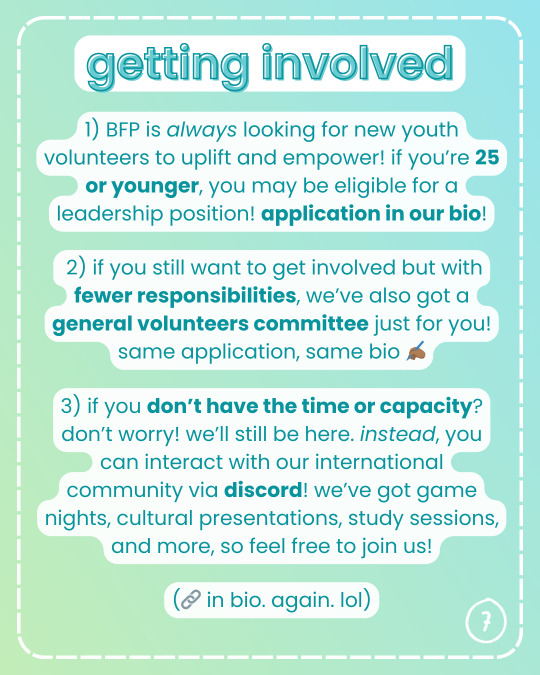
the eighth slide is titled "getting involved" in blue text on a white rectangle. the slide has blue text on white backgrounds which reads, "1) BFP is always looking for new youth volunteers to uplift and empower. if you're 25 or younger, you may be eligible for a leadership position! application in our bio!
2) if you still want to get involved but with fewer responsibilities, we've also got a general volunteers committee just for you! same application, same bio [hand holding pencil emoji]
3) if you don't have the time or capacity? don't worry! we'll still be here. instead, you can interact with our international community via discord! we've got game nights, cultural presentations, study sessions, and more, so feel free to join us! ([link emoji] in bio. again. lol)". in the bottom right corner, the number 7 is circled. End ID.
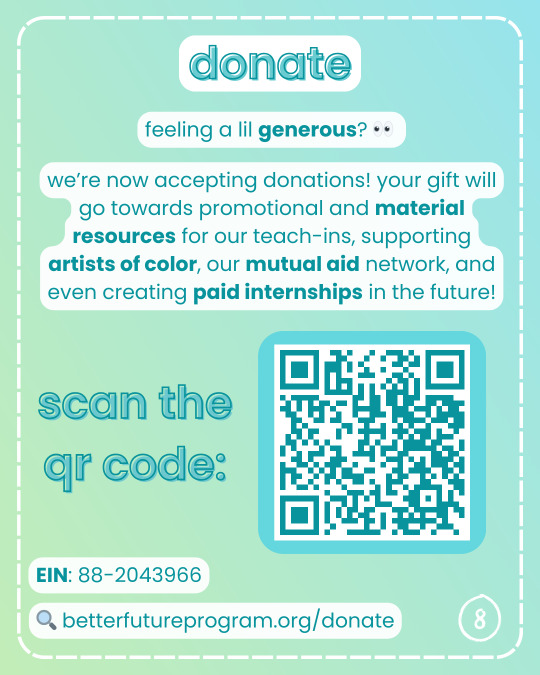
ID: the ninth slide is titled "donate" in blue text on a white rectangle. the subtitle reads "feeling a lil generous? [looking eyes emoji]" in blue text on a white rectangle. the rest of the slide has blue text on white backgrounds which reads, "we're now accepting donations! your gift will go towards promotional and material resources for our teach-ins, supporting artists of color, our mutual aid network, and even creating paid internships in the future!"
below, blue text with a dark blue outline reads "scan the qr code.” it's beside a qr code.
below, blue text on a white background reads "EIN: 88-2043966.”
[magnifying glass emoji] betterfutureprogram.org/donate". in the bottom right corner, the number 8 is circled. End ID.
Welcome, welcome! We'd like to reintroduce ourselves, especially with such an exciting initiative on the way! BFP (@bfpnola) is starting GLOBAL liberation schools and we'd love your support. Get the word out! And if anyone ever asks, "Oh, what's BFP? What are they working on?," just send them this post! 🤍
#reaux speaks#pinned post#youth#youth activism#nonprofit#bipoc#disability justice#anti capitalism#palestine#fat liberation#mad liberation#abolition#anarchism#communism#socialism#decolonization#muslim#jewish#education#free palestine#image described#discord server
141 notes
·
View notes
Text
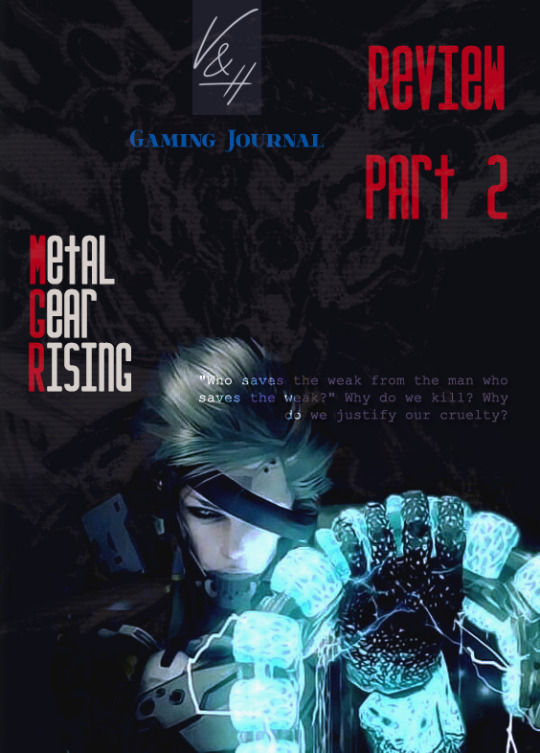
Part 1 is here
It is impossible to defeat nature and its laws. You cannot destroy the established order of things, because sooner or later it will return to the starting point, albeit modified. Part of the eternal order is war. This is a rather conventional character, which, nevertheless, has all the features of eternal evil, which the main character must defeat. Before the battle, Sundowner reveals another revelation to Raiden: he is too blinded and naive to think that he can change the world. War is part of cruel human nature. This is an outdated tool, which we have not been able to completely discard. But like a real virus, rooted in the very middle, it evolved with us, adapting to the conditions of the times.
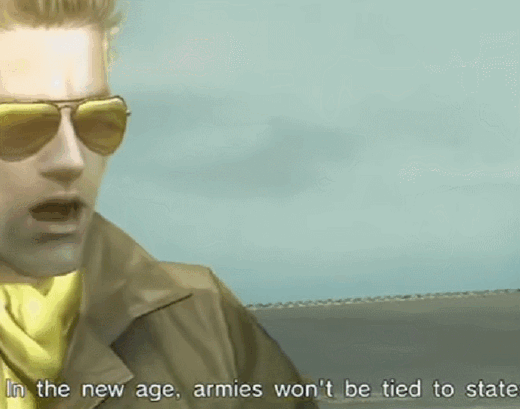
War is indifferent to moral guidelines and honor, deaf to human suffering and merciless to victims. This virus is ready to manifest itself at any moment, as soon as the system crashes. What for Raiden as a person is a matter of morality, for the World Marshal as a large military company is supply and demand. Even the "Patriots", well known to Raiden, did not invent anything new. The fact that after their "disappearance" history continues in the same direction is only proof that the established order cannot be defeated. This is what Sundowner actually says: Raiden with his good intentions will not change the world. PMC has offices all over the world, and therefore their products are in demand. They are only suppliers working for the war market. After all, war is a business hidden behind the face of morality, and the person in it is a commodity.
This again resonates with the rest of the games in the series, where the main unit is not so much the metal gears themselves, but the people behind their creation and control. Of course, the crown of creation of both nature and man is not a perfect tank, but the Legendary Soldier. Big Boss used to be the one. The same fate awaited Raiden. Towards the end, however, MG Rising moves in a slightly different direction, touching on the theme of the "ideal society". As the Patriots once fought for a single ideal world, so Armstrong seeks to create an ideal society where "people will die and kill for what they BELIEVE". Be that as it may, history constantly shows that an imperfect man cannot create a perfect society. After all, it cannot become even the best version of itself. MG has something of the dystopia inherent in the cyberpunk genre. But, at the same time, it remains close to reality, where some wars are fought to stop other wars.
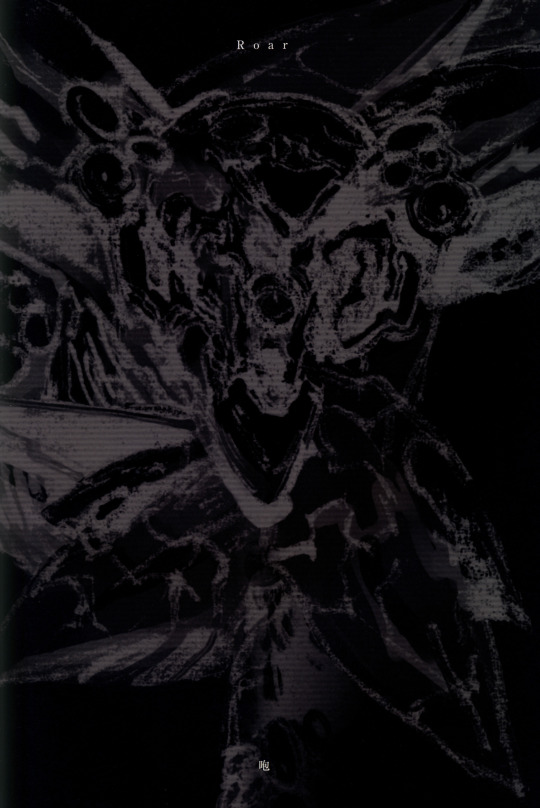
Each war has its own methods of achieving the goal. I like that MG Rising raises the question of the facelessness of the enemies that Raiden kills in packs. Their fate does not interest you as long as it is only a dummy for beating. But as soon as you imagine in front of you a person who has life, destiny and its own will, it becomes morally difficult to destroy them. Maybe that's why it's much more difficult for me to kill innocent NPCs in modern games - they suffer too realistically and look like real people who have their own lives. Giving the enemy human traits is what Sam uses to break Raiden mentally: reality doesn't match his moral principles. It turns out that they are just a cover for his true nature. But as a player, we lean more towards our main character, considering his (that is, our) actions a priori correct. Raiden's reasoning about the sword as an instrument of justice gives us a moral discharge: we destroy the villains who exploit the weak, and therefore do nothing wrong.
But all this is just an illusion. There is no moral attitude that would give a person the right to take the life of another person. "Who saves the weak from the man who saves the weak?" Through the mouths of the characters, the game in a peculiar manner breaks through the fourth wall, addressing the player. Why do we kill? Why do we justify our cruelty? Perhaps Monsoon's phrase that nature cannot be defeated does not mean only the world order. But also a person who has always been marked by cruelty, and therefore cannot defeat himself. As Raiden, we have no right to judge or condemn someone to death. But our internal attitudes, they are memes, give us an excuse, and the game gives us such an opportunity.
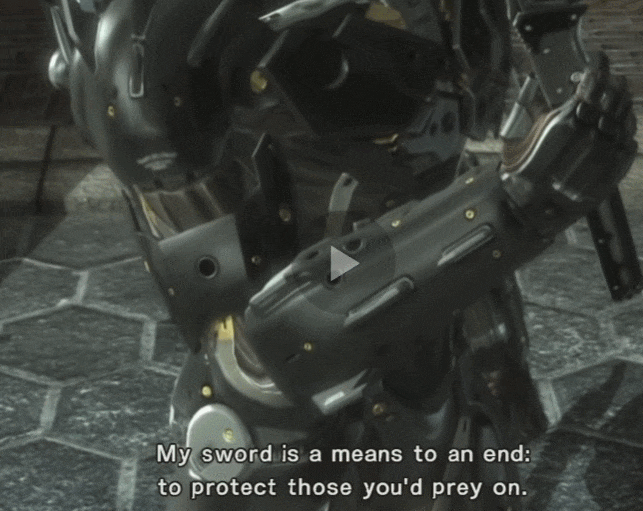
In the general sense, a meme is a unit of information. An attitude or idea that is repeated in different variations and transmitted by imitation or learning. The thesis Meme as a gene was formed by the scientist Richard Dawkins in the 1970s, comparing cultural phenomena with human genes, which copy themselves and are ultimately subject to natural selection. In fact, this is all that Monsoon is talking about: memes (that is, cultural attitudes) influence our behavior, the way we communicate and perceive reality. Culture, religion, our own will - everything is formed from the outside and imposed on us as a given. However, not all cultural phenomena undergo selection. In the struggle for the human mind, the "stronger" meme survives, the one most successfully replicated by the carrier, and therefore more valuable.
Raiden wins with his tool of justice meme Mistral with her thirst for revenge because his beliefs are stronger. But this fake facade of nobility is not enough to defeat Monsoon's nihilistic worldview. Dawkins claims that memes adapt quickly, easily deforming under external conditions. All memes disappear, but are immediately replaced by new ones. Breaking Raiden's unnatural mindset, Monsoon forces him to quickly adopt a new one: "…killing your enemies felt good. Really good <…> I was born to kill <…> Pain… this is why I fight”. Thus, Raiden returns to his original beliefs, where he is Jack the Ripper. Again following Dawkins, memes can change and combine and split, resulting in the formation of new memes. For Raiden, it becomes obvious that you can achieve your goal in another way, by accepting the repulsive part of yourself and using it for good.

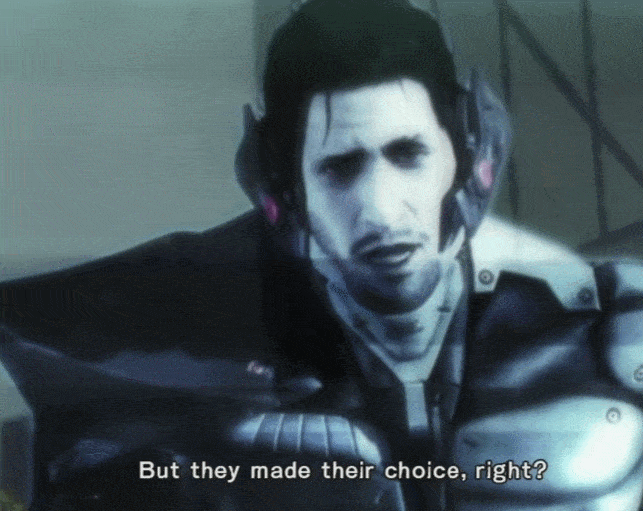
This is the transformation that Samuel could not go through at the time. Unable to handle his thirst for revenge and justice on his own, he falls under the influence of Armstrong's memes. In the end, this makes him doubt his own ideals, and later he rejects them altogether. It's clear from Sam's backstory that he's not a bad guy. Rather, a guy who got into the wrong company and chose the wrong path. There is something in his character about samurai stories, especially the Hagakure - a treatise on bushido - the samurai's unwritten code of honor. The series of stories was created by Nabeshima Mitsushige in 1716. In them, he told the stories of the former samurai Yamamoto Tsunetomo, who after the death of his master became a ronin - an exiled samurai. In short, the meaning of the book can be described by the phrase 'A samurai has no goal - there is only a path', which was attributed to Yamamoto himself (although he did not actually say anything like that).

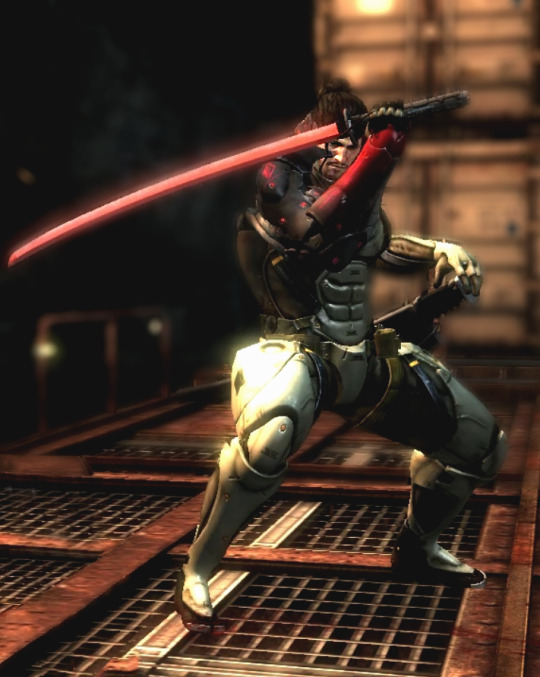
Kuniyoshi (1797 - 1861). Tomimori Sukeemon Masakata from the Biographies of the Loyal Retainers series. Woodblock Print, c. 1847. Source: Ronin Gallery
Sam begins his samurai path to avenge his father's death, but as his purpose crumbles, he becomes increasingly hesitant and ends up becoming a mercenary for terrorists. The transformation from a respected man to a robber was quite a common phenomenon among samurai during the turbulent times of Japanese history. But Sam's path was not in vain and meaningless. Yamamoto commanded the samurai to find their own way in life, discarding thoughts about the past, future and everyday problems. This path was paved on the battlefield with a sword (or rather a bow and a horse), and to die in battle for a samurai is the highest honor. Sam and Raiden's battle was a test of their ideas; a turning point that had to decide whose ideology has the right to exist. Samuel himself speaks about this in his posthumous message.
Both were not enemies, but rather adversaries, each had their own convictions at stake as a kind of equivalent of honor. Sam's mindset and fate shows that personal beliefs do have weight. If they are true and worth fighting for, if they are the same strong memes, they will continue to exist. That is why, finally accepting his nature as an assassin, the sword as a weapon, and the goal as completely achievable, Raiden defeats Samuel.
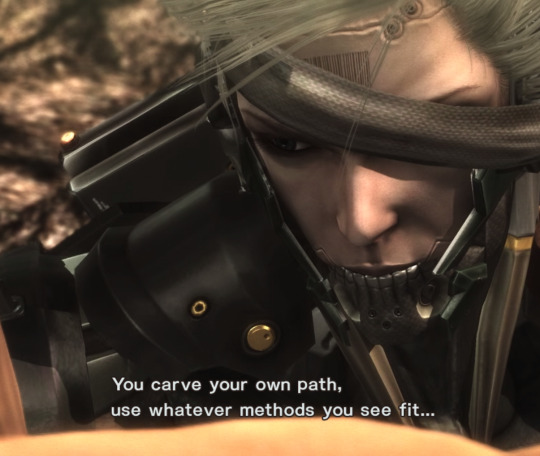
Totally forgot I started to write it, so i had to finish it, haha.
#game review#video games#gaming#videogames#metal gear#metal gear series#metal gear rising#metal gear rising revengeance#mgrr#mgr raiden#raiden mgr#mgr monsoon#samuel rodrigues#jetstream sam#my articles#japanese art#samurai
55 notes
·
View notes
Text
In 2024, increased adoption of biometric surveillance systems, such as the use of AI-powered facial recognition in public places and access to government services, will spur biometric identity theft and anti-surveillance innovations. Individuals aiming to steal biometric identities to commit fraud or gain access to unauthorized data will be bolstered by generative AI tools and the abundance of face and voice data posted online.
Already, voice clones are being used for scams. Take for example, Jennifer DeStefano, a mom in Arizona who heard the panicked voice of her daughter crying “Mom, these bad men have me!” after receiving a call from an unknown number. The scammer demanded money. DeStefano was eventually able to confirm that her daughter was safe. This hoax is a precursor for more sophisticated biometric scams that will target our deepest fears by using the images and sounds of our loved ones to coerce us to do the bidding of whoever deploys these tools.
In 2024, some governments will likely adopt biometric mimicry to support psychological torture. In the past, a person of interest might be told false information with little evidence to support the claims other than the words of the interrogator. Today, a person being questioned may have been arrested due to a false facial recognition match. Dark-skinned men in the United States, including Robert Williams, Michael Oliver, Nijeer Parks, and Randal Reid, have been wrongfully arrested due to facial misidentification, detained and imprisoned for crimes they did not commit. They are among a group of individuals, including the elderly, people of color, and gender nonconforming individuals, who are at higher risk of facial misidentification.
Generative AI tools also give intelligence agencies the ability to create false evidence, like a video of an alleged coconspirator confessing to a crime. Perhaps just as harrowing is that the power to create digital doppelgängers will not be limited to entities with large budgets. The availability of open-sourced generative AI systems that can produce humanlike voices and false videos will increase the circulation of revenge porn, child sexual abuse materials, and more on the dark web.
By 2024 we will have growing numbers of “excoded” communities and people—those whose life opportunities have been negatively altered by AI systems. At the Algorithmic Justice League, we have received hundreds of reports about biometric rights being compromised. In response, we will witness the rise of the faceless, those who are committed to keeping their biometric identities hidden in plain sight.
Because biometric rights will vary across the world, fashion choices will reflect regional biometric regimes. Face coverings, like those used for religious purposes or medical masks to stave off viruses, will be adopted as both fashion statement and anti-surveillance garments where permitted. In 2019, when protesters began destroying surveillance equipment while obscuring their appearance, a Hong Kong government leader banned face masks.
In 2024, we will start to see a bifurcation of mass surveillance and free-face territories, areas where you have laws like the provision in the proposed EU AI Act, which bans the use of live biometrics in public places. In such places, anti-surveillance fashion will flourish. After all, facial recognition can be used retroactively on video feeds. Parents will fight to protect the right for children to be “biometric naive”, which is to have none of their biometrics such as faceprint, voiceprint, or iris pattern scanned and stored by government agencies, schools, or religious institutions. New eyewear companies will offer lenses that distort the ability for cameras to easily capture your ocular biometric information, and pairs of glasses will come with prosthetic extensions to alter your nose and cheek shapes. 3D printing tools will be used to make at-home face prosthetics, though depending on where you are in the world, it may be outlawed. In a world where the face is the final frontier of privacy, glancing upon the unaltered visage of another will be a rare intimacy.
22 notes
·
View notes
Text
In case you missed it: artificial intelligence (AI) will make teachers redundant, become sentient, and soon, wipe out humanity as we know it. From Elon Musk, to the godfather of AI, Geoffrey Hinton, to Rishi Sunak’s AI advisor, industry leaders and experts everywhere are warning about AI’s mortal threat to our existence as a species.
They are right about one thing: AI can be harmful. Facial recognition systems are already being used to prohibit possible protestors exercising fundamental rights. Automated fraud detectors are falsely cutting off thousands of people from much-needed welfare payments and surveillance tools are being used in the workplace to monitor workers’ productivity.
Many of us might be shielded from the worst harms of AI. Wealth, social privilege or proximity to whiteness and capital mean that many are less likely to fall prey to tools of societal control and surveillance. As Virginia Eubanks puts it ‘many of us in the professional middle class only brush against [the invisible spider web of AI] briefly… We may have to pause a moment to extricate ourselves from its gummy grasp, but its impacts don’t linger.’
By contrast, it is well established that the worst harms of government decisions already fall hardest on those most marginalised. Let’s take the example of drugs policing and the disproportionate impact on communities of colour. Though the evidence shows that Black people use drugs no more, and possibly less, than white people, the police direct efforts to identify drug-related crimes towards communities of colour. As a consequence, the data then shows that communities of colour are more likely to be ‘hotpots’ for drugs. In this way, policing efforts to ‘identify’ the problem creates a problem in the eyes of the system, and the cycle of overpolicing continues. When you automate such processes, as with predictive policing tools based on racist and classist criminal justice data, these biases are further entrenched.
83 notes
·
View notes
Text
[It's a video! The one filming, as usual, seems to be Cross, who voices a low, electric "whoaaaaaaaa" as she films the legendary Reshiram, from its talons to the crest of its fluffy head. The dragon seems to be at rest, fluffing out its wings before the camera settles back at its feet on the three people in the room, standing tensely.
Two of them stand together--Tula, and presumably Vanilla, facing Vision in garishly purple robes. Tula's hand rests at her hip, where her sword sits, but Vanilla's position is a bit more diplomatic, hands open in front of them as if to negotiate. Even so, Tula speaks first.
"Where's your boss, Miss Ghetsis Wannabe."
"Boss?" Vision sneered. "He needs me more than I could possibly need him. He's off working on his special little machine, though. Apologies for disappointing you, little grunt."
Before Tula can bite back, Vanilla jumps in.
"So, to be perfectly clear... your plan is to use Reshiram to force people to release their Pokémon. While you have Reshiram captured. And you're saying you're better than Ghetsis was, because...?"
Vision shakes her head. "Hmph. Reshiram and I formed a bond of trust far before I captured them to ensure our plans could succeed. And I intend to give them their freedom, too.
Is it truly so hard to understand that without Pokéballs, Pokémon could still choose to spend their time around humans? Or is that the only way you can envision your bond? As captor and captive?
It would be one thing if all Pokémon chose to join their trainers before being captured, but can you say without a singular doubt that there aren't Pokémon trapped and abused in the current system? If it takes the fire of truth to bring about justice, then so be it!"
"Justice? Don't talk about justice when your 'plan' is going to hurt and kill innocent people and Pokémon!" Vanilla reaches for the sword at his own hip. Negotiations were through.
"If your idea of justice is so perfect, then you can burn with the people you're defending!"
At a swish of Vision's wrist, Reshiram flexes the length of its entire wings, a thrumming noise and a steadily increasing heat filling the room as it activates its Turboblaze. The camera-Pokémon moves closer to her trainer, as she fumbles trying to pick a Pokéball from her waist and hold her sword steady.
They whisper to their partner. "Tula, you should..."
She shakes her head, rejecting the thought of fleeing before it's even finished. "...I'm supposed to protect you."
As the ground, ceiling, and even Cross shake with the force of the charged power, though, the notably absent member of the fight appears with a flash and a Beheeyem, yelling loud enough to overcome the noise.
"In the name of-- do none of you care of what would happen if the ceiling collapsed in on you all, here?!"
Both Vanilla and Vision's fur stands on end. Tula pivots and breathes deep, holding tight to her own sword as Vision responds, her voice cold but even.
"Colress. I have this under control."
"We have an agreement, Vision. Our tools aren't yet prepared. The emotions. The setting... These are far from the ideal experimental conditions. Bide your time."
As Vision grumbles, and as he backs off from the impending attack, Colress gestures at the 'visitors'.
"Now, Beheeyem. Show our guests out, would you?"
As Tula steels herself and lunges at the scientist, yelling something along the lines of "Don't you fucking dare, you fucking--", the camera flashes with blinding light, and the surroundings change from the crumbling ruins of a castle to a lush forest. There's the distinct sound of a thud against the earth, the cry of a Beheeyem, and something hard and plastic hitting the ground before Cross reorients herself to the scene just in time to see Colress's Beheeyem teleport away, and Vanilla rushing to help Tula off of the ground.
"Shit. That must've hurt... are you okay, babe?"
Tula peels herself off of the ground with a sharp intake of breath.
"Yeah... I'm... It's all my fault, I couldn't..."
"No no no," Vanilla assured as a few Zorua wandered over to assess the scene. "You did amazing. We just need to figure out how to deal with that Beheeyem..."
One of the Zorua--the yellow eyes suggest Vanilla's nephew, Bach--nudges over a worn Luxury Ball.
"Huh? What is..."
Vanilla picks up the Pokéball, and the video ends.]
//tagging @plasmaapologist for Tula !
#pzzt! uploaded by cross!#pokeblogging#pkmn irl#high stakes pokeblogging#a vision in the mirror#tw violence#tw threats#tw death mention#ask to tag#long post
13 notes
·
View notes